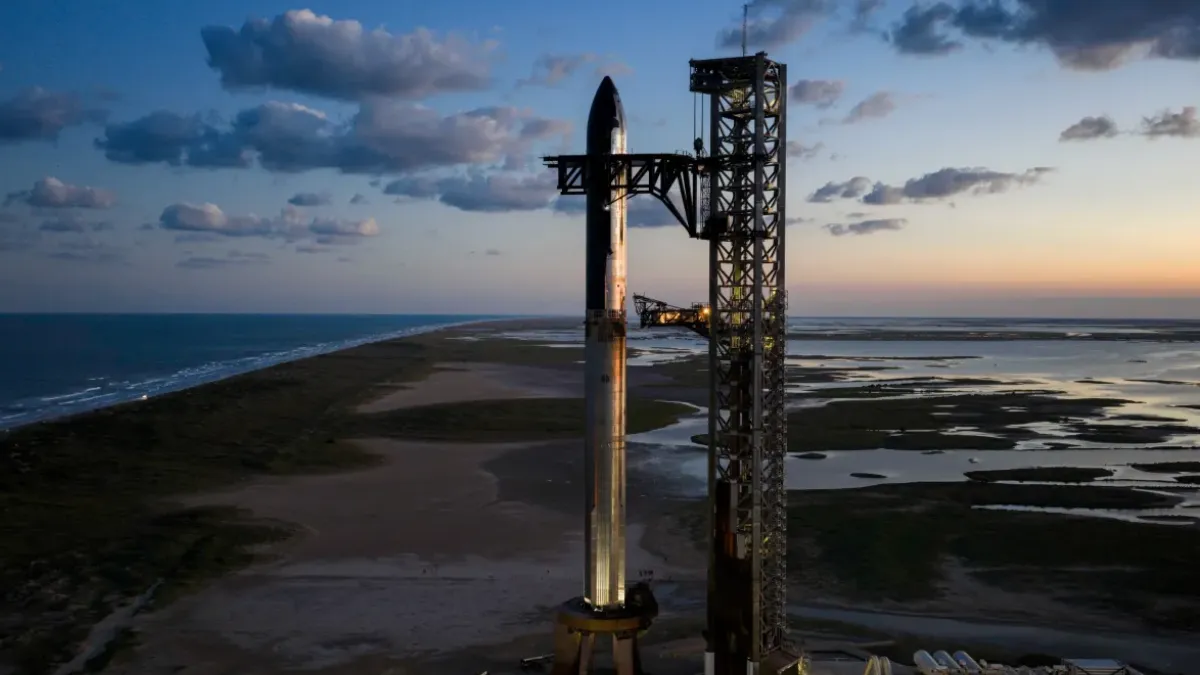Introduction
The world’s attention once again turns toward the skies as SpaceX prepares to launch Starship Flight 11, the company’s most ambitious test yet for its next-generation spacecraft. Scheduled for 7:15 p.m. ET Monday, this test marks a crucial step in SpaceX’s journey toward creating the most powerful and reusable rocket system ever developed. With a blend of technological innovation, environmental controversy, and growing anticipation, Starship Flight 11 is more than just another launch—it’s a pivotal moment for the future of human space travel.
A Challenging Year for Starship Lessons from Test Flights
SpaceX introduced the current generation of Starship vehicles in January 2025, following a series of successful trials with a slightly smaller version of the rocket in 2024. However, this year has proven to be particularly challenging for the ambitious program.
During test flights in January and March, the Starship vehicles exploded near inhabited islands east of Florida. The resulting debris struck roads in Turks and Caicos and washed ashore on various Bahamian islands, highlighting the risks involved in testing such powerful rockets.
A subsequent test flight in May showed improvements in system performance. Yet, the Starship spacecraft lost control as it approached its landing site, and the Super Heavy booster, intended to make a controlled splashdown in the Gulf of Mexico, was completely destroyed.
In June, SpaceX faced another setback when a Starship spacecraft exploded during a ground test, further underscoring the difficulty of mastering this next-generation vehicle.
Engineers and enthusiasts alike finally found a moment of relief with August’s test flight, which successfully concluded with controlled splashdowns of both the Starship spacecraft and the Super Heavy booster. This achievement demonstrated that incremental improvements and lessons learned from previous failures were starting to pay off.
SpaceX frequently emphasizes that the purpose of these test missions is not immediate perfection, but learning from each attempt. Their engineering philosophy, known as “rapid iterative development,” prioritizes building affordable prototypes and conducting frequent test flights over slower, traditional approaches. This method allows the company to refine designs more quickly and cost-effectively, ensuring that each flight contributes valuable insights toward achieving fully reusable, operational rockets.
The Starship Program Setting the Stage for Flight 11
SpaceX’s Starship megarocket is a 400-foot-tall (122-meter) behemoth designed to revolutionize space transportation. It consists of two major stages: the Super Heavy booster, responsible for the initial liftoff thrust, and the Starship spacecraft, designed for space travel and potential reusability.
Since its debut, the Starship project has been a roller coaster of triumphs and setbacks. The company’s Version 2 prototype, introduced in January, has endured a challenging year marked by three in-flight failures and an explosive ground test. However, August’s successful hour-long test flight brought renewed confidence in the program.
Now, with Starship Flight 11, SpaceX aims to validate its improvements and push the boundaries of what reusable spaceflight can achieve. This test is widely believed to be the final mission using the current Version 2 design before transitioning to a more advanced Version 3 prototype.
What to Expect During Starship Flight 11
Today’s test flight will be a carefully choreographed, hour-long mission filled with critical milestones. Each stage of the operation will be monitored closely by engineers and global observers eager to see how far the rocket has come.
Here’s what’s expected to unfold during Starship Flight 11:
1. Final Preparations
Roughly 75 minutes before launch, SpaceX teams will conduct a “go/no-go” poll to determine if conditions are optimal for flight. Once confirmed, the launch sequence officially begins.
2. Propellant Loading
At one hour before takeoff, propellant fueling will commence. The Starship spacecraft and its Super Heavy booster will be loaded with a massive quantity of liquid methane and liquid oxygen, the key propellants powering SpaceX’s Raptor engines.
3. Countdown and Liftoff
In the final 30 seconds, the launch director gives the green light for liftoff. As the countdown hits zero, the Super Heavy booster ignites its engines, propelling the megarocket skyward with a thunderous roar.
4. Booster Separation and Reentry Test
After approximately 2½ minutes, the Super Heavy booster will separate from the Starship spacecraft, having exhausted most of its fuel. About 6 minutes and 40 seconds later, the booster will perform experimental maneuvers and a landing burn off the coast of Texas. However, SpaceX will not attempt to recover the booster this time, focusing instead on data collection.
5. Starship’s Journey Through Space
Following separation, the Starship spacecraft will ignite its engines for about nine minutes, entering a coasting phase through space. Around 18½ minutes after takeoff, the craft will attempt to deploy eight satellite simulators, mimicking an operational satellite deployment.
6. Engine Relight and Controlled Reentry
Nearly 40 minutes into the flight, SpaceX engineers will attempt to relight one of Starship’s engines—a key test for future orbital missions. Finally, about one hour after launch, Starship will reenter Earth’s atmosphere and aim for a controlled splashdown over the Indian Ocean. This maneuver tests the vehicle’s heat resistance and aerodynamic control during high-speed descent.
Environmental Concerns and Ongoing Protests
While SpaceX continues to make strides in technological advancement, Starship Flight 11 hasn’t escaped controversy. Ahead of the launch, environmental activists have once again voiced their opposition to SpaceX’s operations in South Texas.
In August, before the previous Starship test, demonstrators from Conibio Global, a Mexico-based environmental NGO, protested from small boats near the Gulf of Mexico launch area. Their goal was to raise awareness about the potential ecological impact of frequent rocket launches on local wildlife and marine life.
The group reported a disturbing incident during that protest—two unidentified helicopters allegedly approached them aggressively, creating dangerous air blasts that nearly capsized their boats. Though CNN reached out for official comment, U.S. authorities did not respond.
In an October 8 notice posted on social media, Conibio Global announced plans to return for another peaceful protest during Starship Flight 11. This time, they’ve reportedly established communication with U.S. consular officials to formally document any incidents that may occur. Their statement emphasized that demonstrations would remain peaceful but include preventive safety measures.
Such protests underscore the growing tension between technological progress and environmental protection, raising questions about how humanity can explore space without compromising Earth’s ecosystems.
Why Starship Flight 11 Matters
The importance of Starship Flight 11 extends far beyond a single test. It represents SpaceX’s broader mission: to build a fully reusable launch system capable of supporting human missions to the Moon, Mars, and beyond.
NASA has already tapped SpaceX to develop a lunar version of Starship for its Artemis III mission, which aims to return humans to the Moon in 2027. Success with Starship Flight 11 could accelerate that timeline and demonstrate that the vehicle is ready for operational missions.
Moreover, each successful test strengthens SpaceX’s position in the new global space race, where private and national space agencies compete to pioneer reusable rocket technology. Starship’s immense thrust and payload capacity could dramatically reduce the cost of space travel, potentially transforming industries from satellite deployment to deep-space exploration.
Looking Ahead: Starship Version 3
According to company statements, Starship Flight 11 is expected to be the final mission for the current Version 2 prototype. SpaceX plans to introduce Version 3 in its next test flight—a larger, more efficient, and possibly more durable variant of the megarocket.
Version 3 is rumored to feature upgraded Raptor engines, improved heat shield technology, and enhanced reusability systems to allow for quicker turnaround between flights. If successful, this next iteration could bring SpaceX closer to achieving its long-term goal of daily space launches, similar to commercial air travel.
Challenges That Remain
Despite its successes, SpaceX faces significant challenges. The sheer scale of the Starship program, coupled with environmental opposition and regulatory scrutiny, has slowed progress at times. Each test flight carries risks—not only of mechanical failure but also of public backlash if accidents occur.
Additionally, the company must ensure that Starship meets NASA’s rigorous safety standards before it can carry astronauts. That means extensive testing, data validation, and design refinement over the next two years.
Still, SpaceX’s track record of overcoming obstacles, from early Falcon 9 explosions to pioneering reusable rockets, suggests that persistence remains its greatest strength.
Global Reactions and Public Anticipation
Space enthusiasts worldwide are eagerly awaiting Starship Flight 11. Online forums, YouTube channels, and social media platforms are abuzz with countdowns and live-stream links. SpaceX’s test flights have become global events, drawing millions of viewers who share a fascination for innovation and exploration.
For many, these launches symbolize humanity’s unyielding desire to explore—a continuation of the same curiosity that drove earlier generations to cross oceans and climb mountains.
Also read: French Prime Minister Sébastien Lecornu Returns: First Statement After Reappointment
Conclusion: The Future Awaits
As SpaceX prepares for the Starship Flight 11 launch, one thing is certain—each flight brings humanity closer to a new era of space exploration. From environmental debates to engineering triumphs, the mission encapsulates both the promise and the complexity of progress.
Whether today’s test ends in flawless execution or fiery experimentation, Starship Flight 11 will add another chapter to the evolving story of how humankind reaches for the stars.
















